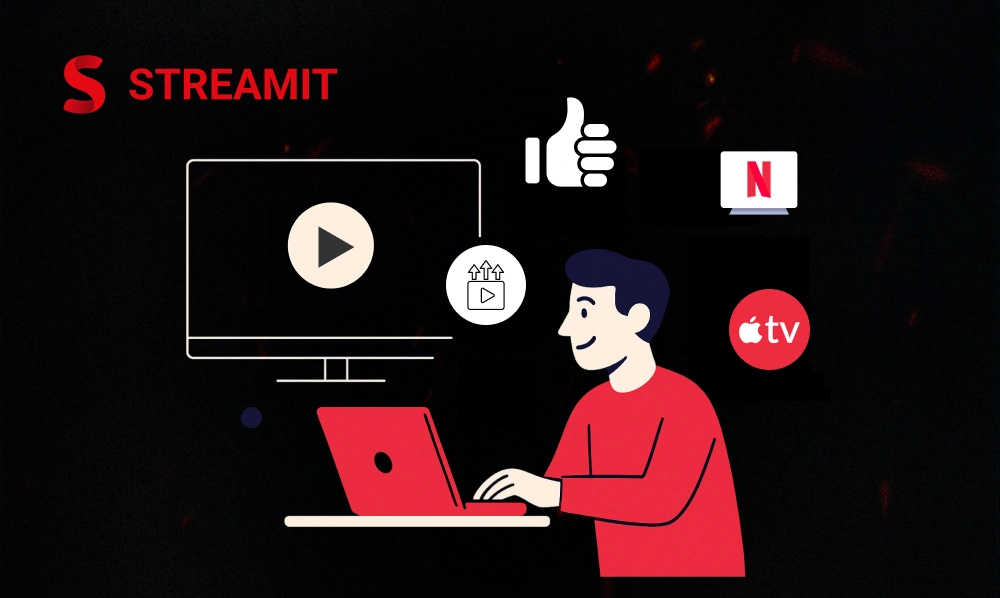Did you know? The global OTT market is expected to reach $434 billion by 2027, growing at a CAGR of 16%. With thousands of platforms vying for audience attention from Netflix to niche local players standing out is more challenging than ever.
Yet despite the crowd, some OTT platforms continue to grow exponentially. What sets them apart? It’s more than just a sleek app or a big content library. Let’s explore the crucial factors that truly make an OTT platform shine in this hyper-competitive streaming landscape.
1. Hyper-personalized User Experience (UX)
In an era where viewers have endless choices, personalization isn’t just nice to have it’s essential. Successful OTT platforms use robust recommendation engines to serve up shows and movies tailored to each user’s viewing habits.
- 80% of Netflix’s watch time is driven by its recommendations.
- Viewers today expect to see content they love right on their home screen not after scrolling endlessly.
But it’s not just about algorithms. The best OTT platforms focus on intuitive navigation, minimal buffering, responsive design, and seamless multi-device experiences. Whether someone’s watching on a smart TV, tablet, or phone, the journey should feel effortless.
2. Strong, Diverse Content Library
Content is still king. However, the game has evolved. It’s not just about quantity anymore quality, exclusivity, and diversity are what hook and retain viewers.
- Platforms like Disney+ surged past 150 million subscribers largely due to exclusive franchises like Marvel and Star Wars.
- Meanwhile, regional players like Hoichoi or Eros Now thrive by offering rich local language catalogs that global giants often overlook.
Originals and exclusives are powerful differentiators. Even smaller OTT platforms are investing in niche documentaries, indie films, or short-form content that resonates deeply with targeted audiences.
3. Localization & Regional Focus
As streaming expands globally, one size doesn’t fit all. A major reason many regional OTT platforms succeed is their deep cultural connect.
- UI in local languages, subtitles, and dubbing widen reach.
- Content rooted in local stories builds loyal communities.
This strategy isn’t just for local platforms. Even Netflix now offers personalized thumbnails and recommendations tailored to regional tastes. The lesson? Understanding cultural nuances can be your biggest growth lever.
4. Flexible Monetization Models
Subscription fatigue is real. With so many paid services, viewers often hesitate to add yet another monthly bill. That’s why leading OTT platforms experiment with diverse revenue models:
SVOD (Subscription Video on Demand) for steady, predictable income.
AVOD (Advertising Video on Demand) that’s free for viewers but ad-supported.
TVOD (Transactional VOD) for pay-per-view or rentals.
Hybrid models that mix subscriptions with ads.
In fact, AVOD revenue is expected to surpass $70 billion by 2027, showing how ad-supported free viewing is booming. Having the flexibility to offer multiple plans makes an OTT platform attractive to wider demographics.
5. Reliable, Scalable Tech Infrastructure
A beautiful app and amazing shows won’t matter if the stream keeps buffering or crashes under load.
- Top OTT platforms partner with solid CDN (Content Delivery Networks) to ensure lightning-fast delivery.
- Multi-DRM solutions keep content secure from piracy.
- Scalable cloud hosting allows platforms to handle millions of concurrent viewers without hiccups.
Companies like streamit it easier by offering powerful, customizable OTT platform solutions that already integrate these tech essentials. This means faster go-to-market and robust reliability from day one.
6. Powerful Analytics for Data-driven Growth
Knowing what viewers watch is good. Knowing why they watch and when they stop is where true competitive edge lies.
- Platforms that deeply analyze viewer drop-off points, watch patterns, and content engagement can fine-tune their offerings.
- Data also helps refine marketing campaigns, improve recommendations, and boost retention.
Modern OTT platforms don’t just deliver content; they listen, learn, and evolve continuously based on analytics.
7. Community & Engagement Features
More viewers now crave interactive experiences, not passive watching. Live chats during events, watch parties, reviews, and even gamified loyalty points keep audiences hooked.
OTT platforms that build community around content see better retention and organic growth. For example, enabling user watchlists, sharing moments on social media, or offering behind-the-scenes extras can turn casual viewers into devoted fans.
8. Marketing that Builds Brand Love
Finally, it’s not enough to build a great OTT platform people need to know about it. Leading platforms invest heavily in:
Digital marketing: SEO-rich content, YouTube trailers, social campaigns.
Influencer partnerships: to tap into existing fan bases.
Smart retargeting ads: to bring back those who dropped off mid-signup.
And importantly, they craft brand messaging that resonates emotionally, not just functionally.
Final Thoughts: The Future is Experience-led
With the streaming market growing at breakneck speed, launching an OTT platform today is easier than ever. Standing out, however, demands relentless focus on viewer experience, local connect, flexible monetization, and continuous innovation.
The platforms that will win aren’t necessarily the ones with the most content or biggest budgets but those that best understand and serve their audience.
So if you’re planning to enter this exciting space, remember:
Build for people first, technology second.
Because in OTT, user delight is the ultimate competitive advantage
(https://blog.streamlit.io/best-practices-for-building-genai-apps-with-streamlit/).







